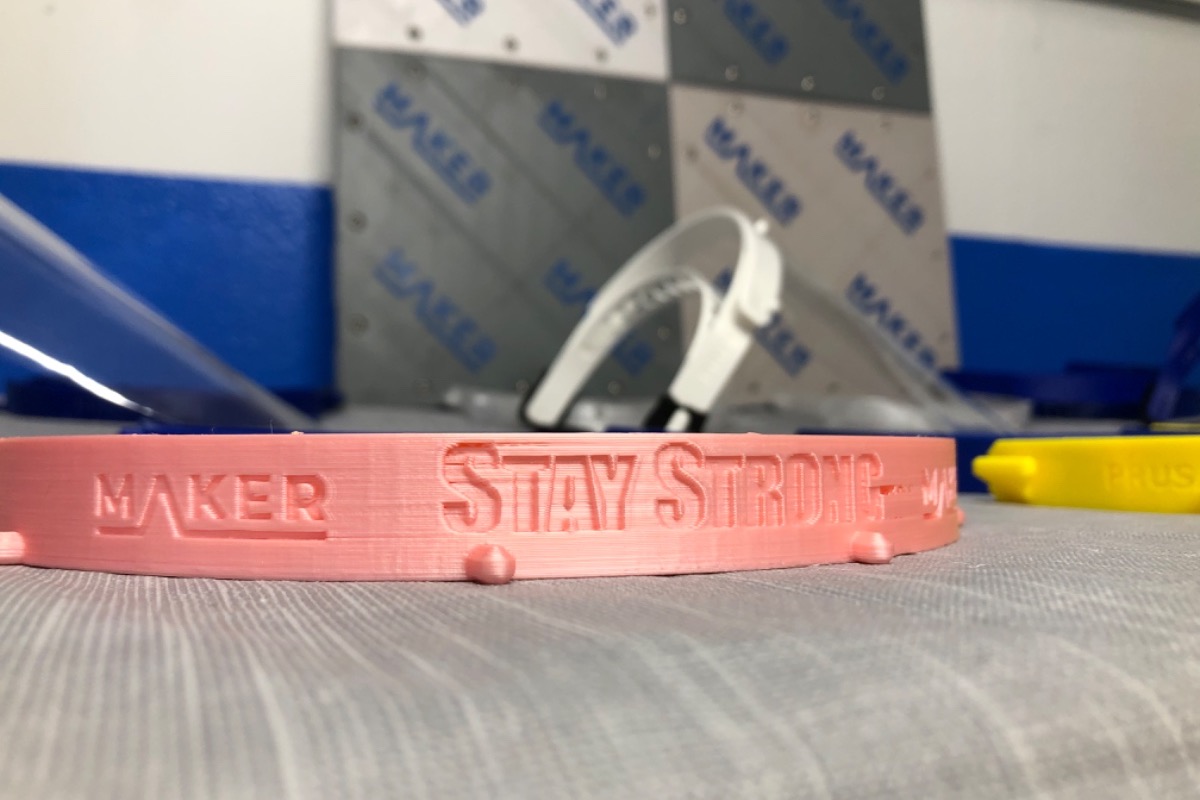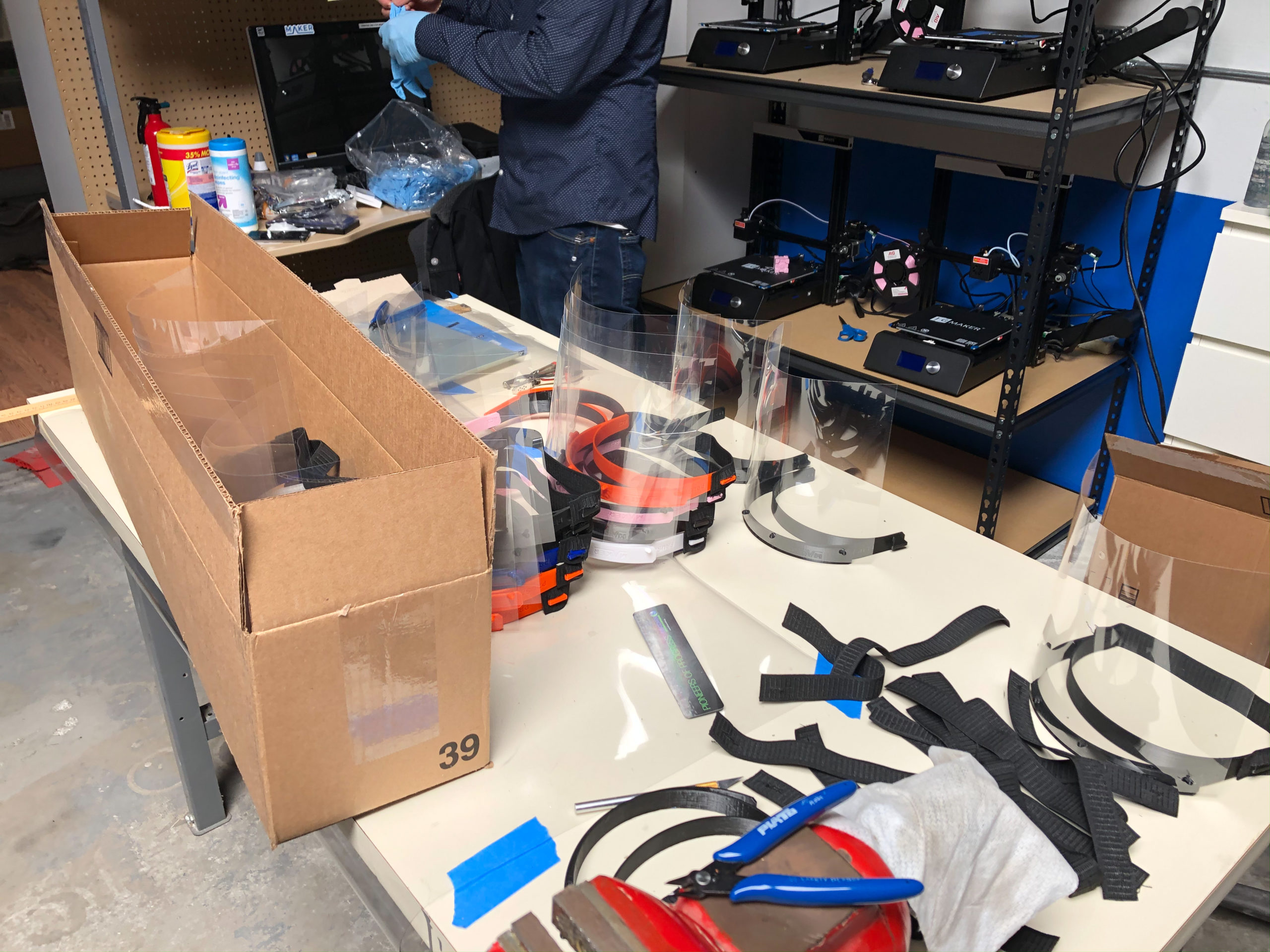Before the spread of COVID-19, The Maker Society operated as a student-run organization that provided 3D-printing resources to students and community members.
It competed in robotics competitions, taught classes about 3D-printing and even created a functional Iron Man suit.
However, once the pandemic began to spread rapidly, Long Beach State students Ambreen Kahn, Danny Curry and alumni Carlos Vergara sat in their workshop in Garden Grove and brainstormed ways they could help make a difference.
“One of the biggest concepts that they kind of ingrained in your head, as both an engineer and industrial designers is creative problem solving,” Curry, a third-year industrial design major said. “How can you get faced with an issue, overcome it through avenues that you didn’t previously consider at all? That idea of being able to have that type of thinking is definitely what got us here.”
After reading stories from overseas of other 3D-printing labs converting into personal protective equipment production companies the team at The Maker Society began printing its own face-shields.
Enlarge

The Maker Society
“We started off actually trying to print a face mask,” Kahn, a fourth-year civil engineering major said. “But we couldn’t get a line that had a good enough seal around your face.”
Curry then found a design for face-shields from a company called Prusa, whose design was approved by the Czech Republic Ministry of Health, and the team decided to run with it.
“It was the closest that any design at that time had gotten to getting a thumbs up from the actual medical industry,” Curry said.
The team began making test batches of the masks but found the production rate was lower than expected, so they decided to switch to another version.
“It’s a significantly simpler design,” Curry said. “And while it hasn’t received any sort of official ‘okay’ from a government entity or health organization, we’ve had hundreds of medical personnel around the country requesting those because they’re significantly cheaper and faster to actually produce.”
Simple, but effective is what the team has been striving for. The current design consists of two pieces that are connected together, a head-band like clip and the face-shield itself.
They began to add messages to the headbands in attempts to add levity and hope to the situation. Some say “STAY STRONG,” which Kahn said is meant for encouragement for everyone.
Enlarge

The Maker Society
“I think it’s a nice message to remind people, and also just to remind us while we’re working and assembling these masks,” she said. “If we stay strong and build these face shields, we can send them out to hospital workers who can also feel like they can be a little stronger.”
Others say “GO BEACH”, something Vergara, who graduated from Long Beach State in 2019 with a degree in aerospace engineering, said is an homage to their roots.
“We got inspiration from the school because that’s where we all started,” Vergara said.
With all 25 of their printers running, Curry said they can make up to 100 masks per day.
After printing the brackets, acetate sheets are cut in the shape of a face shield. The shields are then hole-punched and attached to the bracket, secured and elastic bands are added to secure the mask to the head.
Enlarge

The Maker Society
Throughout the process, the whole team wears their own PPE and all components are sanitized with isopropyl alcohol, dried with a micro-fiber cloth and then dried yet again with a heat gun.
Curry said that the process has been running smoothly, but price-gouging and difficulty accessing supplies has slowed them down.
“Normally, the laws of supply and demand, ‘oh the demand goes up, the price goes up,’” Curry said. “But when it’s something like this, I really don’t think that should be the case.”
The team started a GoFundMe page to help raise money to buy supplies and, as of April 8, has raised over $3,300 of its $5,000 goal.
“We weren’t planning on having a GoFundMe more than probably a couple hundred dollars because originally we were planning on producing very little of these,” Curry said. “However, obviously, as demand has gone up, it’s a matter of we can’t afford to produce the number that we can physically produce.”
Each face shield costs approximately $5 to make and Kahn said that all funds received go directly back into production.
Since beginning its production, the team has entered agreements with St. Mary Hospital in Long Beach, Kaiser Permanente in Downey, a police department in Minnesota, hospitals in Northern California and a non-profit organization called MasksforDocs.
Enlarge

The Maker Society
“We were originally to produce 200, maybe 250 of these,” Curry said. “Now we’re at the point where we’re most likely going to end up producing thousands.”
Curry said that the team has begun building 3D printers from scratch to keep up with the demand for its product. Something Vergara said is no problem at all.
“I hope that they’re less concerned about their own well-being and can be more focused on the people they’re helping,” Vergara said. “Hopefully it can take a little bit off of pressure from themselves getting sick and they can give it their all to helping the people.”
Enlarge

The Maker Society
The Maker Society isn’t the only group within the Beach community stepping up. Christiane Beyer, associate professor in the engineering department, and her team at the University Library’s Innovation Space have begun producing a similar product.
Like the student-run organization, Beyer was inspired by other’s work that she saw on the news.
The professor then began searching for designs to download but said she wasn’t happy with any of the ones available.
“I tried to imagine that in a hospital as a doctor, you’d have to take it on and off and off and on,” Beyer said. “So I said ‘OK, we need a different design’, we need one with maybe two options. One you can wear like regular glasses, so it sits on your ears, but also, in addition, have the extensions that you can put a rubber or elastic band on it.”
So Beyer sat down and created a conglomerate between an FDA approved design, ones she had seen online and her very own design to create the best face-shield possible.
“We can quickly redesign stuff, just for the purpose of right now,” Beyer said. “It might not be FDA approved, but right now it’s any help and support is better than nothing.”
Staff at Student Health Services have been Beyer’s test group, but she has since made contact with the Los Angeles County Department of Public Health to further the reach and distribution of the face shields.
Currently, the lab has eight printers which print different volumes of materials. Beyer said with all printers running at capacity, they can expect to make up to 40 frames per day.
However, they have started to face some challenges in getting the materials they need.
“We start one day, and the next day we get all the proper materials in and then we get the shield material in,” Beyer said. “That’s actually the bottleneck right now, we get our next delivery on Friday.”
Beyer and her team are careful to maintain proper sanitation and PPE standards while producing the masks as well, removing any potential for contamination.
Even though the shift was a sudden one, Beyer said she and her team are happy to be doing whatever they can.
“So many people, they have the capacity like us, we said ‘OK, I’m not going home like everybody right now. Let’s pull our expertise in and offer what we can do on our level’,” Beyer said.
Beyer said that they will begin distributing face shields to local hospitals and health care workers soon. By the end of production, they are looking to make more than 1,000 masks.
For now, both The Maker Society and Innovation Space will continue to make a difference in any way that they can.
“If it’s just one life that we make better, it’s better than not doing anything and not helping anyone,” Kahn said.




